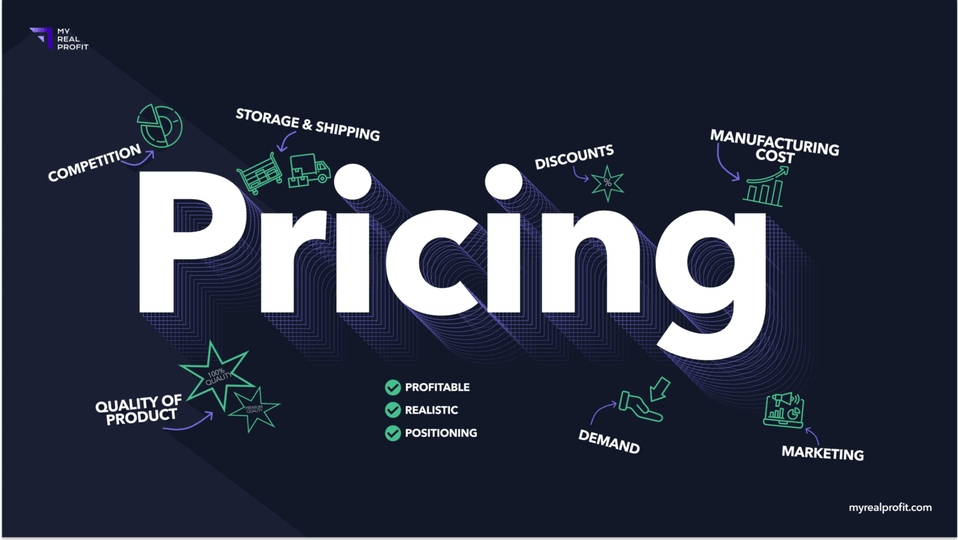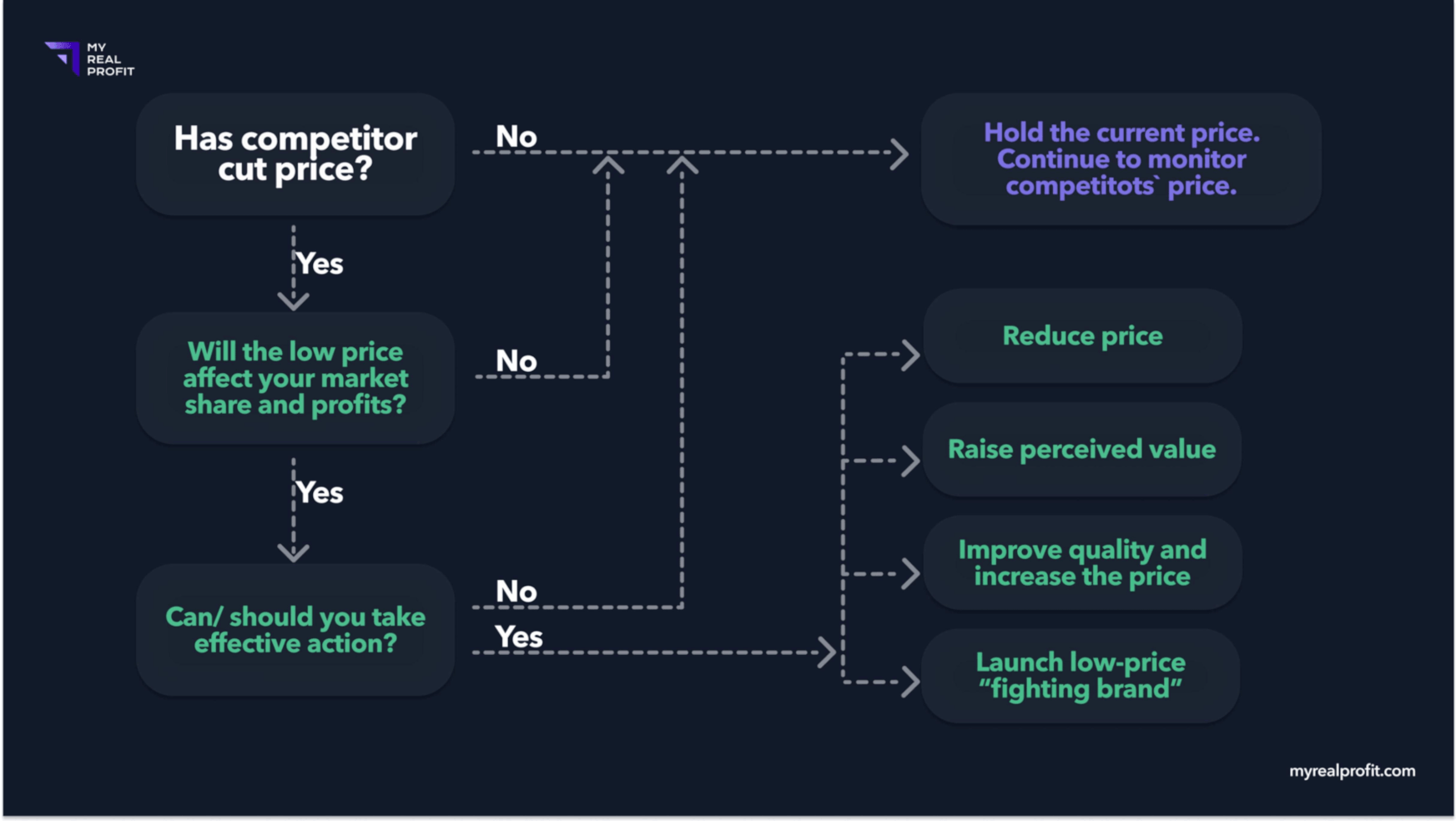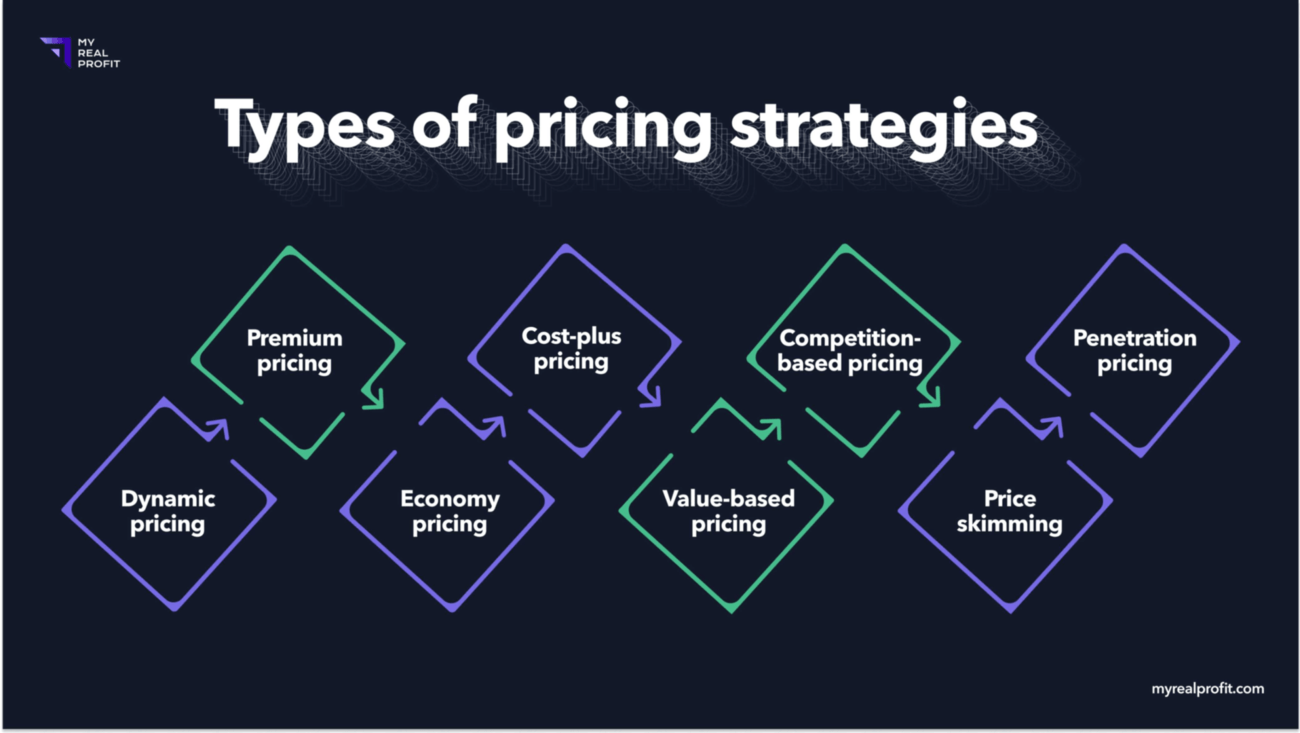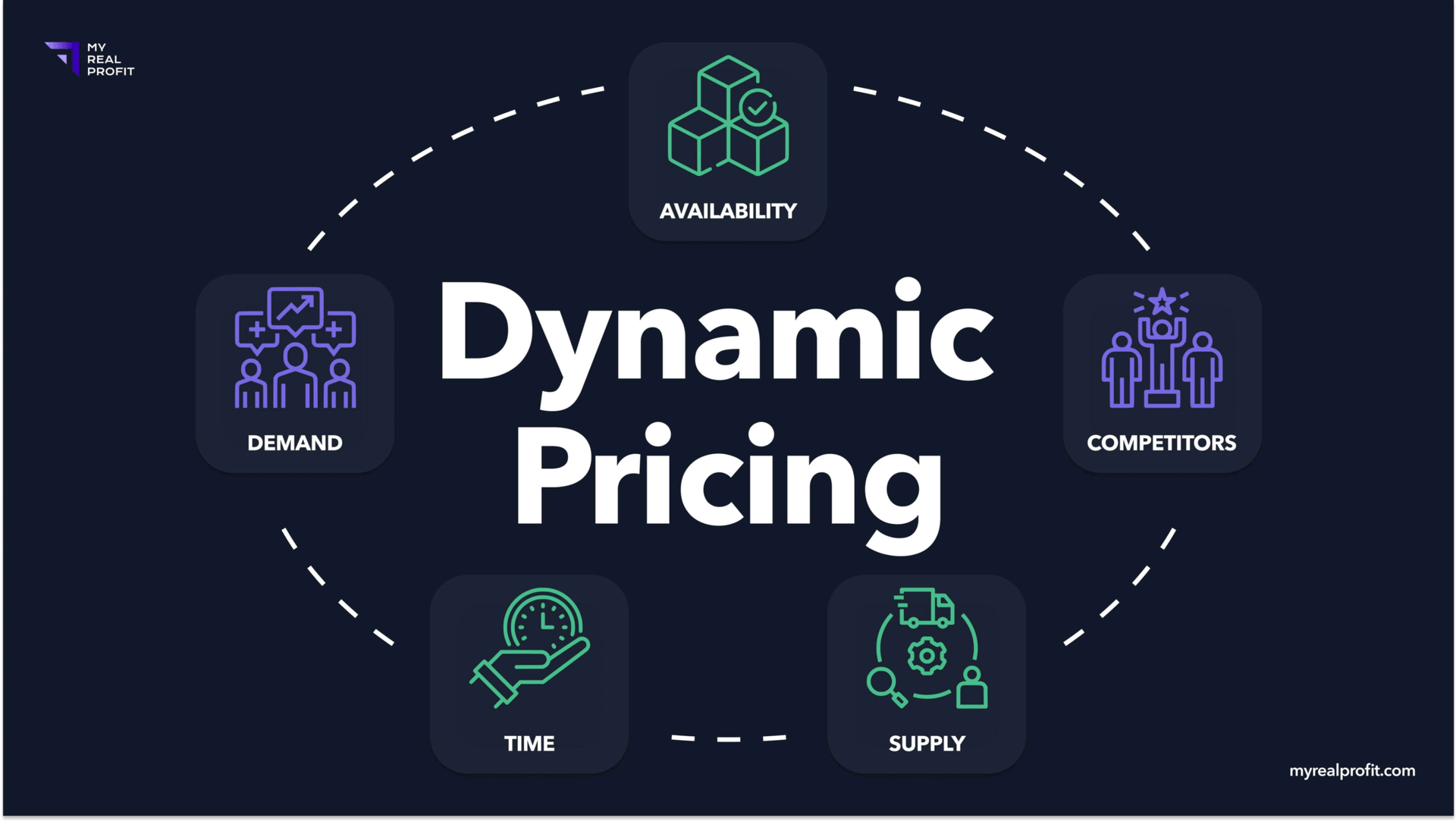Amazon has established itself as the undisputed leader in the e-commerce space. The giant sells more than 4,000 items per minute through its marketplace. Buyers are attracted by favorable prices, the ability to compare and choose the right product, and the convenience of delivery and time savings.
Although the Amazon market is highly competitive, novice sellers can still quickly promote their brand by offering the right product and choosing an appropriate pricing strategy.
A pricing strategy is a systematic approach focused on forming optimal prices for each product. For your business to be truly successful, you must find the best price for your products without sacrificing your profit margins or customers. Let us figure out how to do that.

Amazon Pricing Model
Amazon’s pricing model is based on offering customers the most competitive prices possible. The main goal of Amazon is to keep prices at the lowest price point possible to retain loyal customers and attract new ones.
Therefore, the marketplace uses a dynamic pricing model, which means that the price changes several times a day. Keeping prices low encourages loyalty from their customers and ultimately results in Amazon benefiting from merchants competing for the Buy Box.
Win the Amazon Buy Box
Have you noticed the “Buy Now” and “Add to Cart” buttons on the right side of the product detail page? That’s the Amazon Buy Box. These little buttons allow one lucky merchant or seller to stand out from the crowd. Whenever customers choose either of these two buttons, they buy from that one particular seller.
About 80% of all sales on Amazon are made through the Buy Box. Winning the Buy Box is a guaranteed way to increase your sales. Each Amazon seller with a Pro account has a chance to win the Buy Box if they are selling new items.
A competitive price is one of the crucial factors that Amazon’s algorithm considers when assigning the Buy Box, but it is not the only one. To win the Buy Box, an Amazon seller must meet the basic criteria:
Sign up for Amazon FBA
FBA sellers have an advantage in the fight for the Buy Box button. Once they become an FBA seller, they get powerful promotional tools from Amazon. In addition, Amazon takes care of all packaging, shipping, and customer service.
Products sold by FBA sellers are also eligible for the Prime program, which provides lightning-fast delivery. That does not mean FBM cannot beat the Buy Box; it can, but it is easier to do so with FBA. Always keep track of how much inventory you have and check your inventory reports regularly; having enough stock increases your chances of winning the Buy Box.
If you wanna boost your Amazon sales, you must read it – How to increase sales on Amazon FBA in 2023: Simple tips for more revenue
Fast shipping
To increase your chances of winning the Buy Box on Amazon, it’s beneficial to offer faster delivery. This gives a significant advantage to sellers using FBA or SFP (Seller Fulfilled Prime). Additionally, utilizing faster delivery methods can help improve customer satisfaction.
Quick response
How quickly you respond to customer inquiries affects your chances of winning the Buy Box. The marketplace aims to provide the best customer service. That’s why Amazon tracks response times to customer inquiries, and a delayed response will hurt your seller ranking. Therefore, be prepared to respond to queries and complaints from customers in a short term.
Low price
Amazon’s goal is to provide customers with exceptional products at reasonable prices. Therefore, product pricing is one of the factors in determining the winner of the Buy Box. The cheaper the price for the same product, the better your chances of winning the Buy Box. But you need to be careful and ensure that you do not sell your product at a loss.
How to find the best price for your product
The competitive market makes no concessions for new sellers or seasoned merchants. The price of a product must maneuver between two basic metrics – profit margins and competitive prices.
First of all, determine the minimum and maximum price you can offer, then set an average price that will make you profit but allow you to remain competitive. To do this, use a simple formula for profit margin calculations to set the price correctly in terms of ROI.
Profit margin = (Sales – Total Expenses/ Sales) * 100%
Note that expenses include shipping costs, customs duties, marketing costs, Amazon fees such as FBA fees or customer returns, and other associated costs. Ensure that your price covers all these costs and helps you achieve the profit margins you want. Once you have a good understanding of your expenses, you can begin setting your product prices.
After determining your profit margin and ensuring that you are not selling at a loss, you can compare prices with your competitors to determine if your product is priced reasonably. If competitors’ prices are higher than yours, you may bravely increase prices to have more profits. On the other hand, if competitors’ prices are lower, you have to reduce yours as well to stay at the top and get more sales.
The experience of multiple sellers shows that even a slight drop in price by $0.10 can increase product sales at times. Below are the main signals when a situational price reduction is desirable, even considering the decrease in your profit per item-unit. The main aim of a price reduction should always be to increase your Amazon sales rank, which can in turn lead to increased organic sales later.
Reasons to lower product prices
Lowering prices for new products on Amazon can be a strategic move for sellers looking to increase sales and visibility.
Amazon’s algorithm often favors products with lower pricing, making them more likely to appear higher in search results leading to increased visibility and potential sales.
New products
When a new product is introduced to the market, competing with established sellers can be challenging. If you offer the item at a lower price point, customers are more likely to take the newcomer. Lower prices can attract early adopters, who are always searching for the latest gadgets and trends.
Bundled products
Want customers to buy more products for a single operation? Offering bundled products are a perfect way to accomplish this. Bundle several products together and sell them for one unit’s price or make a considerable discount for a second product.
Special offers
Special offers can include discounts, promotional codes, bundle deals, free shipping, and more. Sellers could create a sense of urgency by running a limited-time offer, such as a lightning deal or a deal of the day.
The most popular time to make special offers is during holidays such as Black Friday, Cyber Monday, or Christmas as consumers are already in a shopping mindset, and there is an expectation of lower prices during these times.
All important dates in one place – Amazon Sellers Calendar 2023: Key Dates for Amazon FBA Sellers. Stay in the driver’s seat!
Overstock
When sellers have a surplus of stock that is not moving, it can result in long-term storage fees or even removal fees if they remain unsold. Amazon sellers can attract price-sensitive customers with the cheapest price.
Not sure if you need to lower your price to follow the competitors? Take a quick test.

Reasons to raise prices
Increase in perceived value
Increasing the price of a product on Amazon can result in a raised perceived value. Buyers often associate higher prices with higher quality, luxury, and exclusivity.
In reality, the perceived value of a product is a delicate balance between competitive pricing, quality, and reputation. Amazon sellers need to navigate it carefully to maximize their profits.
Decrease sales but boost profits
Increasing prices on Amazon can lead to a decrease in sales but can also boost profits for the seller. To maximize profits, sellers need to strike a balance in their pricing strategies.
They should avoid pricing their products too high or too low, as both can lead to a decline in sales and hurt increasing profits.
Low inventory or competitors out of stock
Raising prices can be a logical decision if your competitors are out of stock or if you have low inventory, or are close to running out.
However, it’s important to note that pricing strategies should be balanced and done with care, as a high price can also discourage buyers. Therefore, it’s recommended that sellers conduct market research, evaluate their pricing strategies regularly, and consider their customer’s purchase behavior when making pricing decisions.
Pick the most effective pricing strategies for your business
Any increase or decrease in the price of a product must be deliberate and serve a specific purpose. Your strategy should depend on the kind of product, its status and value, demand, your experience, and many other factors.
Let’s look at different pricing strategies that you can use to scale your Amazon business.

Dynamic pricing strategy on Amazon
Dynamic pricing is a model that allows sellers to choose their own pricing rules. It works by allowing sellers to set prices based on conditions such as supply and demand, market fluctuations, and competition.
Sellers can also use algorithms to adjust prices to achieve a particular business objective. With dynamic pricing, sellers have the flexibility to quickly adapt their pricing strategies as their businesses and markets evolve; this allows them to stay competitive and maximize profits in an ever-changing market.

Repricing involves adjusting prices to stay competitive with your competitors. You set a range of the highest and lowest prices for your product, while maintaining your profit margins, and then adjust your prices within that range to match or undercut those of your competitors. There are three methods for repricing products on Amazon.
Manual repricing
Manual repricing requires sellers to constantly check their competitors’ prices and manually adjust their own accordingly. This strategy allows sellers to adjust their prices depending on market trends or competitors’ pricing, among other factors.
Manual repricing has the following advantages:
full control over your pricing;
useful insights into what works for your products.
It has the following disadvantages:
takes too much time;
not suited for sellers with a lot of listing;
requires expertise and skills in the field.
Automated pricing
Automated repricing on Amazon involves a computer-based algorithm automatically adjusting the product price based on market trends or competitors. This strategy leverages an intelligent algorithm that monitors on a 24/7 basis the competition and adjusts prices instantly based on market trends, competition, and other factors.
Automatic repricing can lead to higher sales volume and increased profitability as the algorithm makes highly accurate price adjustments based on purchasing behavior and customer insights. However, aggressive price wars with competitors can lead to unsustainable profits. That is why implementing repricing strategies must be adequately vetted to make sure that they don’t lead to long-term price wars or reduced profitability.
Automated pricing has the following advantages:
it saves the seller’s time;
you can create pricing rules;
monitoring competition and adjusting prices instantly 24/7.
It has the following disadvantages:
long-term price wars can reduce profitability;
you have to monitor the repricing tool regularly;
price stays the same if you have no pricing competitors.
Algorithmic repricing
Algorithmic repricing on Amazon refers to a strategy where sellers use intelligent software to adjust product prices dynamically based on several factors, including competition, sales history, and purchase behavior.
Algorithmic repricing has the following advantages:
quickly and effectively responding to market changes;
automated pricing saving precious time;
maximizing ROI if used correctly;
easier pricing calculation for huge listings.
It has the following disadvantages:
most of them are expensive;
less flexibility and work strictly established in the parameter settings.
Premium strategy
A premium strategy means marketing your products as premium and pricing them accordingly. To sell premium products associated with a well-known brand, you can use a premium pricing strategy by setting prices higher than those of your competitors.
But this does not always work on Amazon, as consumers may often opt for low prices over brand loyalty, forcing many sellers to offer discounts and offers on their premium products.
Economy pricing
An economy pricing strategy on Amazon involves pricing products at a low cost to appeal to cost-conscious customers. This strategy is designed to maximize sales volume and increase market share.
Products that are priced in this way may have a lower profit margin, but lower marketing costs can offset that. The advantage of using Amazon for an economy pricing strategy is Amazon’s broad customer base and visibility, which can help introduce new products to a large audience.
Cost-plus pricing
The cost-plus pricing strategy on Amazon involves setting the product price by adding a markup to the cost of the product. This strategy helps ensure that the final selling price reflects the costs of creating the product, including production costs, shipping, and operating expenses. The markup can vary depending on the seller’s desired profit margin and market demand.
Using this Amazon strategy, sellers cover their costs and get a profit on each sale. However, this strategy does not take into account other external factors that may influence the final selling price, such as market trends or competitive pricing. Therefore, the cost-plus pricing strategy should be complemented by research on the market demand and competitors’ pricing to ensure the price set is competitive and will still appeal to customers.
Value-based pricing
Value-based pricing strategy involves setting the product price according to the perceived value to the customer rather than simply focusing on the cost of production or competition. This strategy is based on what the seller believes the customer is willing to pay based on how much value the product can offer to the buyer.
Sellers must consider the customer’s needs, product features, and how essential it is for the customer to have such features. Such factors are critical as they determine how valuable and necessary the product is to Amazon customers.
Value-based pricing can result in a higher price for products that offer more features, quality, or benefits, and customers are willing to pay a premium for such products. For private labels, value-based pricing can be a perfect method of standing out as a quality merchant while increasing their margins to the highest possible level.
Competition-based pricing
Competition-based pricing on Amazon is an effective strategy in highly competitive markets. It requires a thorough understanding of the competition and pricing analysis. This strategy involves setting the product price based on the pricing of similar products or competitors. An effective tactic for boosting sales volume is to match, or even slightly undercut, the prices of similar products offered by competitors.
By doing this, the seller can increase awareness and demand for their product, ultimately leading to more sales. However, competition-based pricing can be less effective in niche markets with less competition. Setting a low price can also affect Amazon seller’s profit margin, and the seller needs to consider their production costs to ensure the pricing remains profitable.
Price skimming
Skimming strategy is ideal for merchants who have a unique product but anticipate competition coming their way. This Amazon pricing strategy entails setting a higher price point for a product when it first hits the market, then gradually decreasing the price as more competitors arise.
This pricing tactic allows companies to maximize a product’s sales profit from initial customers before adjusting the price to compete with other sellers as they join the marketplace. The strategy aims to maximize profit in the short term before the competition can catch up.
Penetration pricing
Penetrative pricing is ideal for new sellers and brands just starting with new products and looking to generate more interest from buyers. The main principle of this strategy – merchants first lower their prices, often сonsciously accepting small profit margins to appear on the top of search results and increase interest and sales.
Once they have established a good sales velocity and organic positions, they increase their prices. This pricing strategy can prove to be very useful. However, it may not be sustainable in the longer run.
How to choose the best Amazon pricing strategy
There is no one perfect strategy. Each pricing strategy has its pros and cons and suits certain sellers. What is right for one brand could destroy another. Above all, you must be confident in your product and its availability, understand your customers, and respond to their demands. The next step is to know your competitors and react dynamically to price swings.

Remember, Amazon pricing strategy focuses on the most competitive prices. Your ability to adapt to competitor pricing is critical to stay ahead of them. Your Amazon pricing model should be simple, profitable, and customer-focused.
However, two basic recommendations work for most brands, regardless of category, size, or business maturity.
First of all, a combination of pricing tactics is always better than a single strategy. Each product on your list has a specific place, and you cannot use a single-price s for all SKUs. That means you can use a basic pricing strategy, but should supplement it with elements from the others.
No matter which set of strategies you choose, it is unlikely to be successful without technological support. That is our second recommendation: use modern IT software to automate most Amazon sales processes, but do not let the machine make the decisions for you!
Our team has developed and launched automated analytics software for Amazon sellers – My Real Profit. This software is created for forward-thinking sellers who value their time and need real-time insight into their business profitability, sales, pricing, marketing costs, all kinds of Amazon fees, shipping costs, stock availability and more.
My Real Profit collects all your sales data, crumb by crumb so you can monitor your profitability and spending for each product. You can make informed decisions and establish the best pricing strategy for your business only by analyzing these insightful metrics.
A special offer is available – a 14-day free trial without any credit card. Just sign up and take advantage of the sales with our service.
Final word
To develop a profitable pricing strategy, you need to consider all costs of the product and related expenses. Otherwise, you can go down the drain. Even if it is viable for a short time, it will collapse in the long run.
Every seller is interested in high sales revenue, but the ways to achieve this goal are varied. Amazon’s competitive market is built around customer satisfaction. If your product is good, attractively priced, and your satisfied customers leave positive feedback, you can be at the top and win the Super Buy Box button. This will boost your visibility on the marketplace even more and drive customers up.
At any stage of your business, set concrete goals and build your pricing strategy around them. Combine different Amazon pricing strategies depending on the product and its features. Once the target is reached, you need new targets and possibly new price strategies.
This tactic will help you use the most profitable Amazon pricing strategies, offer the right price, and win the race for customer attention.


